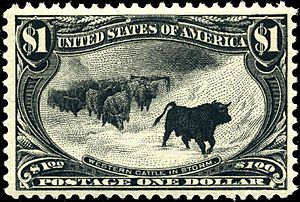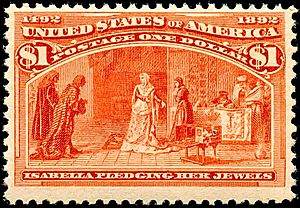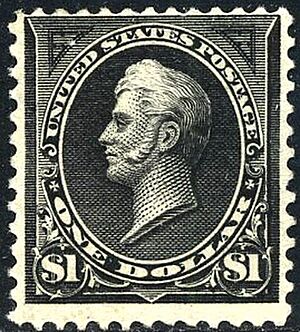Western Cattle in Storm facts for kids
Quick facts for kids Western Cattle in Storm |
|
|---|---|
 |
|
| Country of issue | United States |
| Country of production | United States |
| Location of production | Washington, D.C. |
| Date of issue | June 17, 1898 |
| Designer | Raymond Ostrander Smith |
| Engraver | Marcus W. Baldwin & Douglas S. Ronaldson |
| Printer | Bureau of Engraving and Printing |
| Commemorates | Trans-Mississippi Exposition |
| Depicts | John MacWhirter's The Vanguard |
| No. printed | 57,000, 56,900 issued to post offices |
| Face value | $1 |
| Estimated value | Used: $265-$500 Fine mint $1,700-$3,000 |
The Western Cattle in Storm is a special $1 stamp. It was released by the United States Post Office Department in 1898. This stamp is part of a set of nine stamps. They were made to celebrate the 1898 Trans-Mississippi Exposition in Omaha, Nebraska. Many stamp experts think this whole set is one of the most beautiful ever made in the U.S. The $1 stamp, also called the Black Bull, is especially famous.
The cattle on the stamp were meant to show the tough spirit of the American West. However, the cattle actually came from the Highlands of Scotland. This is because the design came from a painting by John MacWhirter in 1878. His painting, called The Vanguard, showed cattle in a winter storm in central Scotland.
An engraving of this painting was used by an American cattle company. They put it on their calendar as a kind of trademark. The Post Office Department saw this image and liked it. Raymond Ostrander Smith, a designer, chose it for the $1 stamp. He did not know the scene was from Scotland, not the American West. Later, an apology was given to the painting's owner. Marcus W. Baldwin engraved the stamp's main picture and its border. Douglas S. Ronaldson added the numbers and letters.
Contents
How the Stamp Was Made
The stamp's unique dark, almost black color makes it very special. This color was chosen only a few days before printing began. Earlier designs looked much less dramatic. The $1 stamp and the other eight stamps in the series were first planned to be two-toned. The main picture would be black, and the borders would be different colors.
For example, early designs of the cattle stamp had a brownish-purple border. But then the Spanish–American War started in April 1898. The Bureau of Engraving and Printing became very busy making other stamps. So, they decided to print the Trans-Mississippi series in single colors to save time. The $1 stamp was first going to be light brown. But on May 26, just four days before printing, the public learned it would be black.
The printing of the Western Cattle in Storm stamp took three days, from June 1 to June 3, 1898. The Bureau of Engraving and Printing sent 56,900 copies of the stamp to post offices.
When the Stamp Was Sold
The first Trans-Mississippi stamps reached postmasters on June 15, 1898. The official first day they could be sold was June 17. There was a lot of excitement about the stamps before they came out. This caused a rush to buy them when they first appeared.
However, this interest did not last long. As more stamps became available, the newness wore off. Sales to postmasters stopped on December 31, 1898. Any stamps that were not sold after that were destroyed.
Before this stamp, only two other $1 U.S. postage stamps had been made. One was the $1 Columbian Exposition stamp from 1893, called Isabella Pledging Her Jewels
. The other was the $1 Oliver Hazard Perry stamp from 1894
.
What Experts Think of the Stamp
Today, the Western Cattle in Storm stamp is seen as one of the most beautiful U.S. stamps ever. But not everyone always agreed. John Luff, a famous stamp writer, did not like it much. In 1902, he wrote that the stamps were "poorly conceived and executed." He thought they had too many decorations and looked blurry.
However, by 1933, another writer named Ralph Kimble praised the stamps. He called them "perhaps the most attractive set of commemoratives." He especially liked the $1 stamp. In 1934, Stamps magazine asked readers to vote for the most beautiful stamp in the world. The Canadian 1928 50¢ Bluenose stamp won first place. The Western Cattle in Storm stamp came in second.
Today, stamps like Western Cattle in Storm that are in perfect condition can sell for many thousands of dollars.
Reissue of the Stamp
In 1998, the U.S. Postal Service reissued all nine Trans-Mississippi stamps. They were printed on a special souvenir sheet. They also made a separate sheet with nine copies of just the "Western Cattle in Storm" stamp. Unlike the 1898 versions, the 1998 stamps were printed in two colors.



